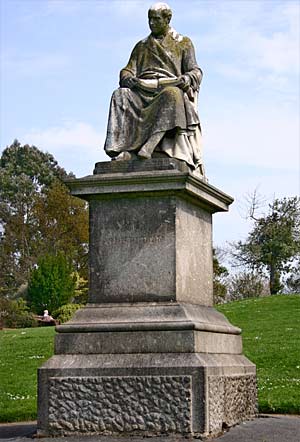
Statue of John Dinham
Page updated 6 June 2009
This statue of John Dinham is in Northernhay Park. It was sculpted by E B Stephens who also sculpted the 'Deer Stalker', among others, that can also be found in the park. It was suggested that a statue in honour of Dinham be erected at a meeting in July 1864, two weeks after his death was announced. Soon, a healthy correspondence appeared in the Flying Post regarding the site for the new artwork. The first site to be selected was Bury Meadow, but some objected, while one letter writer felt it should be positioned by the Free Cottages at Mount Dinham, which Dinham had provided. It was eventually agreed that it should be placed in Northernhay Park, on a west facing slope, from where, it was then possible to see his Free Cottages at Mount Dinham.
It was unveiled on 26th March 1866, a fine day, with a large crowd in attendance. After a speech by S T Kekewich MP which ended with "I therefore esteem it a great honour to be called upon to fulfil this duty, and in the name of five hundred subscribers I present to you, Mr. Mayor, and through you to the city of Exeter to succeeding generations of citizens and inhabitants the statue of John Dinham." There was enthusiastic cheering then "At this point the Rifle Band struck up the National Anthem and Mr. Stephens, the sculptor, uncovered his work amid general cheering." However, there was a sting in the tail for they went on "... but taken as a portrait we cannot pay Mr Stephens the compliment of saying that it is his happiest style."
The pedestal has inscribed upon it "Erected by the Citizens of Exeter and others, in his piety, integrity and charity 1866."
John Dinham was a local philanthropist who came from a poor background. Born at Kenton on the 5 August 1788, his father was the farm bailiff at Powderham Castle, the ancestral home of the Earl of Devon. Dinham went to work for a grocer in the High Street, Exeter at the age of 14, before. After working in a chemists, Dinham opened a silver and jewellery shop without much success and reverted to selling groceries. After his marriage in 1808 proved to be unhappy, he was bankrupted. He was appointed as a manager of a London based tea importer which, after a few years, was to be closed. With the help of friends, Dinahm purchased the business. This was a turning point, and within a few years he had become a wealthy man. He married again in 1831, after his first wife had died, and became a member of the Church of England.
His strong religious conviction led him to found Sunday Schools, help initiate the YMCA and support Dumb and Blind Institutions. He built forty two Free Cottages above Weir Cliff, in 1860, as retirement homes for the poor, in the area now known as Mount Dinham. He also opened the Rack Street Infant School, during 1858, in the West Quarter. John Dinham died in June 1864, leaving £21,000 to charitable causes.
Sources: Flying Post. Kelly's 1897

│ Top of Page │